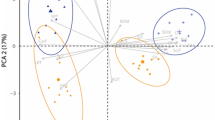Abstract
The hypothesis that lenticels may act as a gate for light penetration through the highly light absorptive periderm, was investigated. Yet, transmittance of isolated periderms from ten tree species was considerably higher in the non-lenticel than in the lenticel regions. Depending on species, the lower transmittance of lenticels was due to either higher reflectance and/or higher absorptance. Corticular tissue regions below lenticels were more shade acclimated. Chlorophyll fluorescence images showed lower PS II effective yields, a lower potential for non-photochemical quenching and a possibly higher risk of photoinhibition in the corticular areas under the lenticels in most of the cases.



Similar content being viewed by others
References
Anderson JM (1986) Photoregulation of the composition, function, and structure of the thylakoid membranes. Annu Rev Plant Physiol 37:93–136
Björkman O (1981) Responses to different quantum flux densities. In: Lange OL, Nobel PS, Osmond CB, Ziegler H (eds) Encyclopedia of plant physiology, NS. Physiological plant ecology I, vol 12A. Springer, Berlin Heidelberg New York, pp 57–107
Brugnoli E, Scartazza A, De Tullio MC, Monteverdi MC, Lauteri M, Augusti A (1998) Zeaxanthin and non-photochemical quenching in sun and shade leaves of C-3 and C-4 plants. Physiol Plant 104:724–734
Cernusac LA, Marshall JD, Comstock JP, Balster NJ (2001) Carbon isotope discrimination in photosynthetic bark. Oecologia 128:24–35
Genty B, Briantais J-M, Baker NR (1989) The relationship between quantum yield of photosynthetic electron transport rate and quenching of chlorophyll fluorescence. Biochim Biophys Acta 990:87–92
Kauppi A (1991) Seasonal fluctuations in chlorophyll content in birch stems with special reference to bark thickness and light transmission, a comparison between sprouts and seedlings. Flora 185:107–125
Kharouk VI, Middleton EM, Spencer SL, Rock BN, Williams DL (1995) Aspen bark photosynthesis and its significance to remote sensing and carbon budget estimate in the boreal ecosystem. Water Air Soil Pollut 82:483–497
Langenfeld-Heyser R (1997) Physiological functions of lenticels. In: Rennenberg H, Eschrich W, Ziegler H (eds) Trees—contribution to modern tree physiology. Backhuys, Leiden, The Netherlands, pp 43–56
Langenfeld-Heyser R, Schella B, Buschmann K, Speck F (1996) Microautoradiographic detection of CO2—fixation in lenticel chlorenchyma of young Fraxinus excelsior L. stem in early spring. Trees 10:255–260
Levy PE, Allen SJ, Jarvis PG (1999) The effect of aqueous transport of CO2 in xylem sap on gas exchange in woody plants. Tree Physiol 19:53–58
Manetas Y (2004) Probing corticular photosynthesis through in vivo chlorophyll fluorescence measurements: evidence that high internal CO2 levels suppress electron flow and increase the risk of photoinhibition. Physiol Plant 120:509–517
Maxwell K, Johnson GN (2000) Chlorophyll fluorescence—a practical guide. J Exp Bot 51:659–668
Pfanz H, Aschan G (2001) The existence of bark and stem photosynthesis in woody plants and its significance for the overall carbon gain. An eco-physiological and ecological approach. Prog Bot 62:477–510
Pfanz H, Aschan G, Langenfeld-Heyser R, Wittmann C, Loose M (2002) Ecology and ecophysiology of tree stems: corticular and woody photosynthesis. Naturwissenschaften 89:147–162
Pilarski J (1984) Content of chlorophyllous pigments in shoot bark and leaves in Syringa vulgaris L. Bull Pol Acad Sci Biol 32:415–423
Schaedle M (1975) Tree photosynthesis. Annu Rev Plant Physiol 26:101–115
Schmidt J, Batic F, Pfanz H (2000) Photosynthetic performance of leaves and twigs of evergreen holly (Ilex aquifolium L.). Phyton 40:179–190
Schönherr J, Ziegler H (1980) Water permeability of Betula periderm. Planta 147:345–354
Solhaug KA, Gauslaa Y, Haugen J (1995) Adverse effects of epiphytic crustose lichens upon stem photosynthesis and chlorophyll of Populus tremula L. Bot Acta 108:233–239
Wittmann C, Aschan G, Pfanz H (2001) Leaf and twig photosynthesis of young beech (Fagus sylvatica) and aspen (Populus tremula) trees grown under different light intensity regimes. Basic Appl Ecol 2:145–154
Wutz A (1955) Anatomische Untersuchungen über System und periodische Veränderungen der Lenticellen. Bot Stud 4:43–72
Ziegler H (1957) Über den Gaswechsel verholzter Achsen. Flora 144:229–250
Author information
Authors and Affiliations
Corresponding author
Rights and permissions
About this article
Cite this article
Manetas, Y., Pfanz, H. Spatial heterogeneity of light penetration through periderm and lenticels and concomitant patchy acclimation of corticular photosynthesis. Trees 19, 409–414 (2005). https://doi.org/10.1007/s00468-004-0399-7
Received:
Accepted:
Published:
Issue Date:
DOI: https://doi.org/10.1007/s00468-004-0399-7




